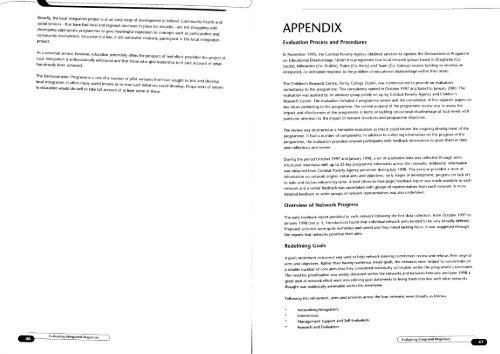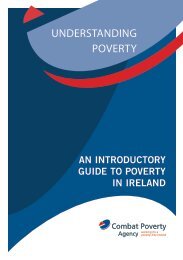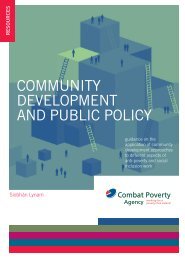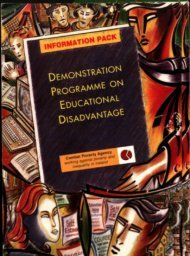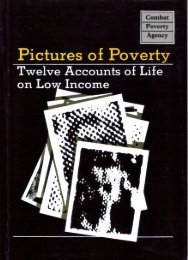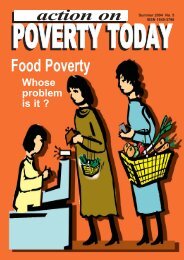Evaluating Integrated Responses to Educational Disadvantage (2000)
Evaluating Integrated Responses to Educational Disadvantage (2000)
Evaluating Integrated Responses to Educational Disadvantage (2000)
- No tags were found...
Create successful ePaper yourself
Turn your PDF publications into a flip-book with our unique Google optimized e-Paper software.
"We wanted it not <strong>to</strong> be seen that we were choosing. We didn't want <strong>to</strong> target, I suppose, becausewe wanted an openness about it... So from all the schools in the area we had one reply... It was anintimidating experience for them. None of them replied because they were not ready <strong>to</strong> buy in<strong>to</strong> it.some said they got the letter but they were not quite sure really. I think it is a process as well ofactually applying." (Home-school-community co-ordina<strong>to</strong>r: interview)It was decided that a more targeted recruitment drive was needed and the home-school-community liaisonco-ordina<strong>to</strong>rs became directly involved in assisting this process. This targeting helped get the parents onboard straight away. Having a home-school-community co-ordina<strong>to</strong>r within the school with whom parentscould identify and ask questions of helped tremendously with the project's overall acceptance. Thirty-twoparents started the training and 26 completed. Feedback from the training was positive: "It was veryenjoyable." "We wanted it for longer."Tralee Education Network, Co. Kerry (TEN)BackgroundTralee <strong>to</strong>wn is located on the south-west coast, in Co. Kerry. Traditionally, it was a rural market <strong>to</strong>wn and hasa population of over 25,000 of whom 40 per cent are aged 25 years or younger. The <strong>to</strong>wn and its hinterlandshad been included in the Local Development Programme. Within the local Partnership's catchment area, therewere pockets of disadvantage, with high levels of unemployment and educational disadvantage, most notablythrough early school-leaving, within the <strong>to</strong>wn's local authority estates and the depopulated rural hinterlands.Before participation in the Demonstration Programme, there had been an Early School-Leavers' Committee.This had commissioned a report <strong>to</strong> examine the extent and nature of early school-leaving and <strong>to</strong> makerecommendations regarding ways of addressing the needs of this target group 10 .v"It gave us more confidence that there was no fear of going and knocking on somebody's door. Itwas that this can be done and it can be done nicely and if you are just a bit more aware ofdifferent cultures, different lifestyles and sort of not <strong>to</strong> be critical, and you are there <strong>to</strong> do your bitand so get on with it. You are not there <strong>to</strong> look at their house or <strong>to</strong> see how clean their children are.Of course, if you did see anything that you thought was a bit strange you could mention it <strong>to</strong> thehome school liaison and she would pick up from there." (Parent visi<strong>to</strong>r: interview)The first round of the programme focused on the transfer of pupils from infants' school <strong>to</strong> primary. Parentswere asked if they wanted a visit first and had the opportunity <strong>to</strong> refuse it. The visit provided information onthe new school and what the children were likely <strong>to</strong> encounter. The information varied from school rules andpolicies <strong>to</strong> uniform. Visits lasted from 30 minutes <strong>to</strong> an hour and a half. The time spent depended on thepersonality of the visi<strong>to</strong>r."A typical visitYou knock on the door. Say hello! Introduce yourself.They have got a note saying thata visi<strong>to</strong>r will be calling and they are given a time. I got a great response. I actually went on my firstvisit <strong>to</strong> a girl in her pyjamas giving her baby her breakfast and the other little one was runningaround. We were giving colouring books and crayons as an icebreaker and I must say a greatresponse I had everywhere - even from ones that had kids that had already gone through theschool. They were surprised that there was so much going on now compared <strong>to</strong> when the otherswere going <strong>to</strong> school." (Parent visi<strong>to</strong>r: interview.)The focus of the visits was <strong>to</strong> help allay fears, <strong>to</strong> address the difficulties that children with particular needsmight face and <strong>to</strong> act as a stepping-s<strong>to</strong>ne between parents and the school.AimsThe Demonstration Programme was seen as an opportunity <strong>to</strong> implement an integrated response <strong>to</strong>preventing early school-leaving and <strong>to</strong> broaden the scope of the Committee's work in<strong>to</strong> other issuesconcerning educational disadvantage.StructureThe Early School-Leavers' Committee consisted of representatives from the vocational education committee,probation service, FAS, youth training centres, Partnership Company, education centre, youth service, preschoolplaygroups, and Traveller development groups. After the network started <strong>to</strong> function effectively, schoolpersonnel were involved in the network's issue-based groups but were absent at network steering committeelevel (see below, Activity). This situation changed through 1998-1999, however.ActionsIn the first few months, the network established a steering committee, made up of representatives of the keyagencies involved in initiating the network, and recruited a co-ordina<strong>to</strong>r. It also engaged an independentfacilita<strong>to</strong>r <strong>to</strong> support the steering committee's development through its early stages. The facilita<strong>to</strong>r organiseda series of workshops and team-building exercises designed <strong>to</strong> develop a shared mission and action plan forthe network. These exercises were particularly important in developing trust and building relationships withinthe network. TEN succeeded during its early stages in getting most of the key players, such as VEC, youth andprobation services, engaged in the network.^The mam aim is the link - the link between parents out there (in the community), parents here (inthe school) and the school. (It is) just <strong>to</strong> have somebody <strong>to</strong> approach. (The link) is <strong>to</strong> make it moreaccessible for the parents <strong>to</strong> go in<strong>to</strong> the school.The hds think nothing of it (But), you would besurprised the amount of parents who just leave their children <strong>to</strong> the school gate and feet 7 wont goin.lt,s almost as if they feel that it is the children's domain and (they) shouldn't be involved butnow it is not just the children, the parents can be involved also." (Parent visi<strong>to</strong>r: interview)It is hoped that the programme will encourage parents <strong>to</strong> attend school meetings. There was no negativefeedback from the v,s,<strong>to</strong>rs. Parents implemented the programme. It was considered part of the officialstructure because of the involvement of the home-school-community co-ordina<strong>to</strong>rs but it was seen as deprofessionalised.An unforeseen benefit of the Droarammo h*< h QO „ ,,,,,,„ , „ rK , „ programme has been that the parent visi<strong>to</strong>rs see themselves aspart of KEN (and one has |oined its steerinq qrouo) It is envi^nori th*t n.y y.uup,. it is envisaged that the service will be expanded furtherboth in terms of numbers and focus.TEN adopted a primary role of supporting inter-agency groups, groups that were either already in placebefore TEN was set up or new inter-agency structures formed for specific purposes. These inter-agency groupswere collectively referred <strong>to</strong> as Issue-Based Networks. Such networks could be described as either interventionnetworks or discussion networks.The Issue-Based Networks included:* Co-ordination of Interventions;* Inter-Agency Forum on Traveller Education;* Literacy Network.' Moriarty, A. (1996), School's Out - Listening and Responding <strong>to</strong> the Needs ot Early School-leavers in Tralee.Tralee: Tralee Early School-Leavers' Committee.( <strong>Evaluating</strong> <strong>Integrated</strong> <strong>Responses</strong>o


